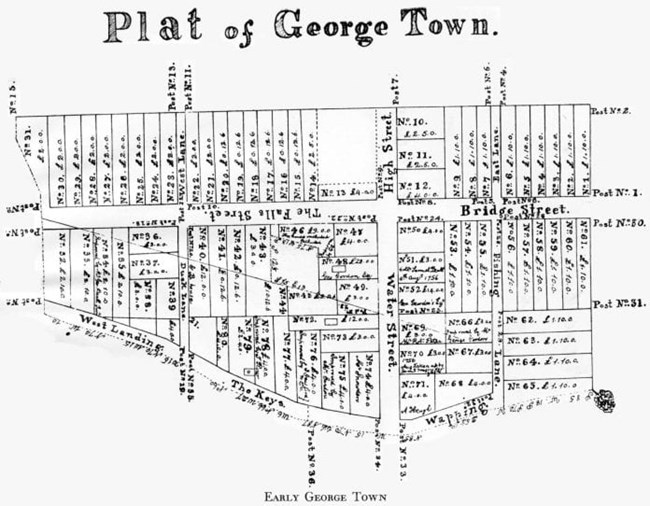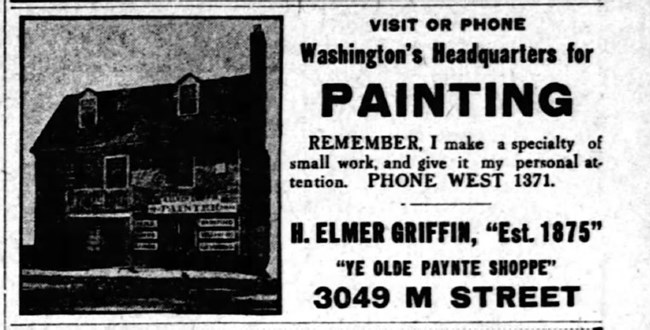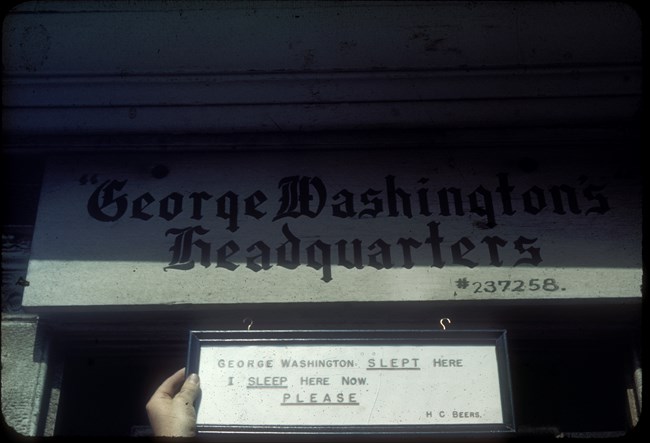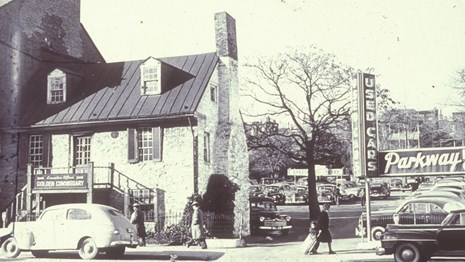Before there was Georgetown...Before Georgetown became a posh neighborhood in Washington, DC it was the site of a Native American trading village. The land that now encompasses the Georgetown neighborhood of Washington, DC was utilized by the Indigenous People of the Eastern Algonquin Culture. These cultures are represented today by the Piscataway, Pamunkey, and other tribal groups.Historically, we do not know what other tribes may have come through this area. Fishing, hunting, gathering, and trading likely happened near the waterfront. Tribes used forested lands nearby for hunting, fishing, gathering, and stone quarrying.Henry Fleet returned to the area after he had escaped captivity with a group of Piscataway in the 1630s. He had learned the language and the topography of the area and set up a trading post to take advantage of the abundant commerce being done. By 1634 when the first English settlers arrived to the new colony of Maryland, Fleet was well established on the banks of the Potomac. The late 1600s and early 1700sThe Potomac River was a deep and navigable river up to where Georgetown sits today. Ocean going vessels could sail inland, load goods into cargo holds and sail back to European markets. Many of these ships sailed up the Potomac River mostly empty and were loaded with large quantities of tobacco to be taken overseas. George Gordon established a warehouse for checking, grading and storing tobacco close to the spot where Rock Creek joins the Potomac River. He owned several large tracts of land in what would eventually become Rock Creek Park and the District of Columbia. In 1751 the Maryland State Legislature authorized that a town be created on the Potomac River on land that belonged to Gordon and a man named George Beall. 
Gutenberg Lot #3Old Stone House sits on a plot of land that on early maps was marked as Lot #3, a property facing Bridge Street (now named M Street NW). It was first purchased by John Claggett in 1752 for one pound and ten shillings and then by John Boone in 1762 for the same amount. Both men forfeited Lot #3 due to a lack of "improvement" on the lot.A person wanting to keep the land they purchased had to “erect, build, and finish, thereon, one good and substantial house, that shall cover four hundred square feet of ground at least, “ with one brick or stone chimney." In 1764, Christopher and Rachael Layman traveled from Pennyslvania with their two sons to begin a new life in the growing port of George Town along the Potomac River. For one pound, ten shillings, they bought Lot #3, and soon began to improve the land. Unfortunately Christopher died in 1765, leaving the widowed Rachael to continue with construction on Lot #3. Not much is known of what exactly was constructed on Lot #3 by Rachael Layman. For example, we do not know if the house had multiple stories or just a loft. We do know that the house is constructed of local blue fieldstone, quarried about two miles upriver, and solid oak boards, hewn with a pit saw. The backbreaking labor and skill of the builders is evident in the well-placed stones and evenly-laid ceiling beams. The marks left by the massive saw used to cut the ceiling beams can be seen in the room that may have housed the Layman family (the bookstore). The Laymans' simple house was functional: stone walls two to three feet thick and packed dirt floors protected the family from harsh weather, while low ceilings conserved heat from the hearth fire. Female Owners and Land LadiesRachael LayhmanRachael retained ownership of Lot #3 and a substantial structure in 1766. In 1767, after marrying a man named Jacob Furvey, Rachael traded Lot #3 for a different lot owned by a woman named Cassandra Chew. Rachael and the Furvey's dissapear from the records after this time. Cassandra ChewCassandra Chew was a member of the upper-middle class. Her wealth included real estate in and around George Town, as well as enslaved people. Mrs. Chew’s wealth enabled her to make signifcant additions to the house on Lot #3. She fnanced construction of the rear kitchen and second and third foors by 1775. According to census data, she did not live in the house on Bridge Street. She lived in a large brick home on a different lot in George Town with her younger daughter, Harriet. Lot #3 and several other lots in George Town were held in trust and were technically owned by Harriet, or Cassandra's other daughter, Mary. The property on Lot #3 was used as a rental and was a source of income for Cassandra during her lifetime. Upon her death in 1811, Mrs. Chew bequeathed Old Stone House to her eldest daughter, Mary Smith Brumley. Like her mother, Mrs. Brumley was financially comfortable. Mary Chew Smith BrumleyMary Chew Smith Brumley lived on Lot #3 in what would become known as the Old Stone House in 1790. She is listed as head of household living with six of her children.Mary moved away from Lot #3 when she remarried. She retained ownership of Lot #3 and used the property the same way her mother had, leasing out space and earning an income. At one point, her daughter, Barbara, and son-in-law, John Suter Jr., lived in the house with their family. It is possible that Barbara and John met while he was renting the front room from Mary to use as a clock and watch making shop. Mary died in 1825 and bequeathed the house and Lot #3 as follows: ½ to her daughter, Harriot Smith, ¼ to her daughter, Cassandra Chew McKenzie, ¼ to her granddaughters Sarah Maria and Ann Suter. Cassandra Mckenzie gave her 1/4 share of the lot to Sarah Maria Smith Bowie in 1835. Sarah Maria and Harriot Smith split the earnings from the lot 50/50. In 1875 two men by Richard Marcey and Calvin Payne purchase Lot #3. For the first time in over 100 years it was not owned by women or by a descendent of Cassandra Chew. 
Washington Herald Late 19th and Early 20th Century ownersRichard Marcy and Calvin PayneMarcy and Payne owned several lots on the block and further developed Lot #3. They leased Old Stone House to several men, and as early as 1879, the front room was the site of a paint shop. This business (or others like it) would continue into the 20th century. Census records indicate that families unassociated with the paint shop business lived upstairs and other businesses and residences were also on the lot. In 1889 Richard Marcy died. By 1890, Lot #3 had new owners.
The Goddard FamilyIn 1890, James and Morgan Goddard purchased Lot #3 and the buildings on the property. The front room at Old Stone House continued to be a paint shop while the Davis Family (unassociated with the paint business) lived upstairs. Other families lived on the lot indicating large structures that would allow for boarders. Several businesses existed in the structure to the east of Old Stone House with tenants living behind it. The title passed to Alice and Frederick Goddard when Morgan died in 1918 and they owned the property until 1940 when they sold it to Harris and Rosa Levy. 
NPS George Washington’s Headquarters?Though signs and commemorative plaques appeared on the house labeling it as Washington's Headquarters, there was always doubt. Detailed research by National Park Service historian Cornelius Heine helped shed light on the actual story and debunked the mythology that had helped save the house for almost 200 years. What building was it mistaken for?In 1790, when the District of Columbia was established under the Residence Act,a man named John Suter operated a successful tavern close to the waterfront called "The Fountain Inn." His business was also known as Suter's Tavern and was well known to offer the best hospitality in Georgetown. When George Washington had business in the city, he often stopped at The Fountain Inn. 
Federal Government purchases Lot #3Old Stone House continued to be privately owned until 1953, when the federal government purchased the property for $90,000 in response to local residents who had come to regard the house as one of historical significance. The Golden Commissary operated in the front room of the house while the Parkway Motor Company used the upstairs area as offices. The rest of the lot had been paved over to accommodate the vehicles. The government purchased the house, the land the house sat on, and as much property as still existed from "Original Georgetown Lot #3." This wording proved vital since a sliver of the house extends over the original property line between Lot #3 and Lot #4.Preservation WorkA brief archeological dig was conducted inside the house with help from the Smithsonian Institute. Evidence of past businesses helped shed light on what the house was and was not. From the archeological evidence, it was clear that the house had never been a tavern or inn. Based on artifacts, and an unidentifiable foundation found beneath the floor boards it is believed that the front room of the house may have been used for whisky production, baking, printing press base (print found), glazing, painting and possibly “gas production.”For seven years, the National Park Service (NPS) worked to preserve the house and bring the interior back to the way it may have looked around 1800. One of John Suter, Jr.’s tall case clocks, which may have been built in the house over two hundred years ago, was purchased by the NPS and brought back to the house. |
Last updated: April 3, 2025
